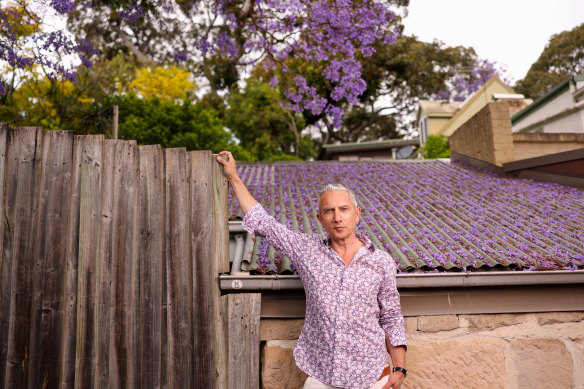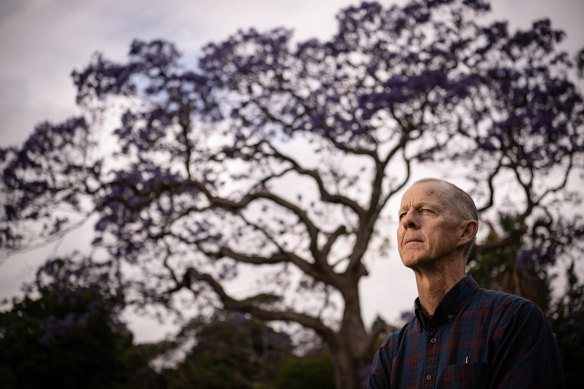By Julie Power
As Sydney poet Warren Paul Glover walked his dogs under jacaranda trees, he couldn’t shake the imagery of the spent flowers left on the ground.
Those images inspired his poem Jacaranda Season. It celebrates the trees’ carpet bombs: a “deciduous delight” of “lilac lethality” on “pedestrian foot soldiers” who “march through the purple parade”.
To mark this year’s season in Sydney, Brisbane and Grafton, where the 90th annual jacaranda festival celebrating its 2000 trees began on Friday, the Herald is launching the 2024 Purple Prize for Poetry.

Purple patch in Paddington: Warren Paul Glover is a poet who wrote about jacarandas in Jacaranda Season.Credit: Dylan Coker
Write a poem in any style about the jacaranda in fewer than 50 words and you could win a jacaranda tree of your own. Submit it to editor@smh.com.au by Tuesday 9am AEDT.
Sydney’s oldest jacaranda in the Royal Botanic Garden is now in flower, and social media posts about jacarandas have gone “petalistic”.
Native to Brazil and introduced to Australia from the 1850s, the trees across Sydney are now budding, blooming or patched with green.
At one of Sydney’s most popular and Instagrammable spots, Kirribilli’s McDougall Street where the trees line the road next to the waterside Milson Park, the trees have begun flowering, but not all are in full bloom, a council spokesperson said.
At peak jacaranda, some roads will be closed to cars at weekends. Council said there had been an increase in foot traffic, but not enough to close roads this week.
This year Sydney’s jacarandas are a mixed bunch. In contrast to years when they have been blanketed in flower, the vegetation varies now. Some are covered in flowers, others are producing mostly fern-like leaves that add to their beauty.
Many individual trees are sprouting flowers on north-facing branches while other branches produce leaves and few to no flowers.
Chief scientist and director of science, education and conservation at the Royal Botanic Garden in Sydney, Dr Brett Summerell, said the reasons for this were a mystery.
Flowering was often controlled by light or temperature, and could require exposure to both for set periods. “I expect that with the jacaranda it is a cumulative exposure to temperature, and this gets reached more quickly to the north,” he said.
Summerell spotted flowers on the garden’s Jacaranda mimosifolia in early October, making it one of the earliest sightings in about 20 years.

Brett Summerell with some of the Royal Botanic Garden jacarandas in bloom.Credit: Wolter Peeters
The trees have long prompted poetry as purple as the flowers they carry. A poem in the Herald by M. Bourbon in 1924 tracked the evolution of the jacaranda from “rough, grey bark and bare, with no hint of loveliness within until late October days go hotly by”.
In 1923, Emily Bulcock likened sitting under a jacaranda to being in a temple where a mystic thing, by angels kissed, dropped its frail blooms to a scented tomb. “Oh, it was sermon, song, and prayer,” Bulcock wrote.
Glover’s poem Jacaranda Season was published in his book Fashionably Late, available from Ginninderra Press.
Jacaranda Season by Warren Paul Glover
The jacaranda tree carpet bombs
its lilac lethality on the concrete below,
a deciduous delight
– if only too brief --
to the pedestrian foot soldiers
marching through the purple parade
of Sydney in spring.
The Morning Edition newsletter is our guide to the day’s most important and interesting stories, analysis and insights. Sign up here.